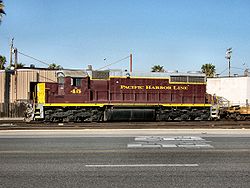Pacific Harbor Line
 | |
 An SD20-2 engine owned by Pacific Harbor Lines works at Long Beach, California. | |
| Overview | |
|---|---|
| Headquarters | Wilmington, California |
| Reporting mark | PHL |
| Locale | Port of Los Angeles/Port of Long Beach, California |
| Dates of operation | 1998–present |
| Technical | |
| Track gauge | 1,435 mm (4 ft 8+1⁄2 in) (standard gauge) |
| Length | 18 mi (29 km) |
| Other | |
| Website | http://www.anacostia.com/railroads/phl |
The Pacific Harbor Line (reporting mark PHL) was formed in 1998 to take over the (HBL). In 1998, the Alameda Corridor was nearing completion, allowing for a massive amount of railroad traffic from the largest harbors in the Western hemisphere: Port of Los Angeles and Port of Long Beach.
The railroad has 18 route miles (29 km) with a web of 59 miles (95 km) of track.
Overview[]
The PHL was formed to create a level playing field for shippers. Up to that time, the HBL was owned and operated by the major railroads in Los Angeles; the Southern Pacific, the Santa Fe Railway and the Union Pacific. One of the problems with the HBL arrangement was that a shipper could have problems getting their goods to or from the port depending on where an individual railroad's track ended.
The PHL, privately owned by the Anacostia & Pacific Company, operates on tracks and facilities owned by the ports. The PHL is a neutral switching railroad that serves shippers at this large port complex. PHL handles 40,000 carloads of freight a year excluding intermodal traffic. The Alameda Corridor provides rail service to port complex through BNSF and UP railroads.
PHL was the first railroad to have its locomotive fleet composed only of Tier II and Tier III "clean diesel" locomotives.
Pacific Harbor Line was named the 2009 Short Line Railroad of the Year by Railway Age magazine.
In July 2013, Pacific Harbor Line signed a new five-year collective agreement with the Brotherhood of Locomotive Engineers and Trainmen (BLET).[1] BLET has represented workers at the company since PHL was formed in 1998.[1]
On March 31, 2020, Eduardo Moreno attempted to crash a Pacific Harbor Line train into the hospital ship USNS Mercy, which was in the Port of Los Angeles to provide Los Angeles with additional hospital capacity during the COVID-19 pandemic in California, but the train stopped approximately 250 yards (230 m) from the ship.[2]
References[]
- ^ a b Bowen, Douglas John (July 15, 2013). "Pacific Harbor Line, BLET sign pact". Railway Age. Retrieved July 17, 2013.
- ^ "Prosecutors: Engineer deliberately ran train off tracks in attempt to smash the USNS Mercy". KABC-TV. April 2, 2020. Retrieved April 3, 2020.
Further reading[]
- Fickewirth, Alvin A. (1992). California railroads: an encyclopedia of cable car, common carrier, horsecar, industrial, interurban, logging, monorail, motor road, shortlines, streetcar, switching and terminal railroads in California (1851–1992). San Marino, CA: Golden West Books. ISBN 0-87095-106-8.
- Robertson, Donald B. (1998). Encyclopedia of Western Railroad History – Volume IV – California. Caldwell, ID: The Caxton Printers, Ltd. ISBN 0-87004-385-4.
- Stindt, Fred A. (1996). American Shortline Railway Guide (5th ed.). Waukesha, WI: Kalmbach Publishing Co. ISBN 0-89024-290-9.
- Walker, Mike (1997). Steam Powered Video's Comprehensive Railroad Atlas of North America – California and Nevada – Post Merger Ed. Faversham, Kent, United Kingdom: Steam Powered Publishing. ISBN 1-874745-08-0.
External links[]
| Wikimedia Commons has media related to Pacific Harbor Line. |
Coordinates: 33°46′42″N 118°14′40″W / 33.77833°N 118.24444°W
- California railroads
- Companies operating former Atchison, Topeka and Santa Fe Railway lines
- Companies operating former Southern Pacific Transportation Company lines
- Companies operating former Union Pacific Railroad lines
- Switching and terminal railroads
